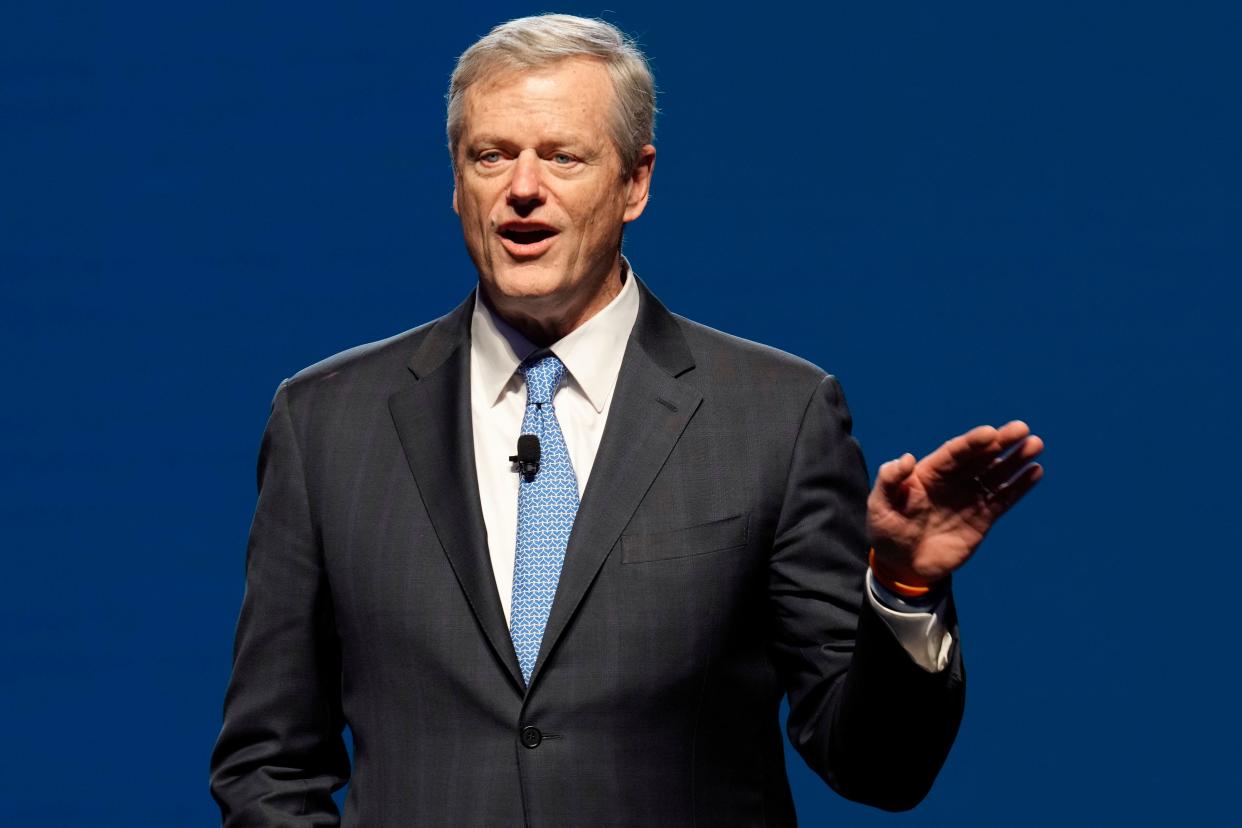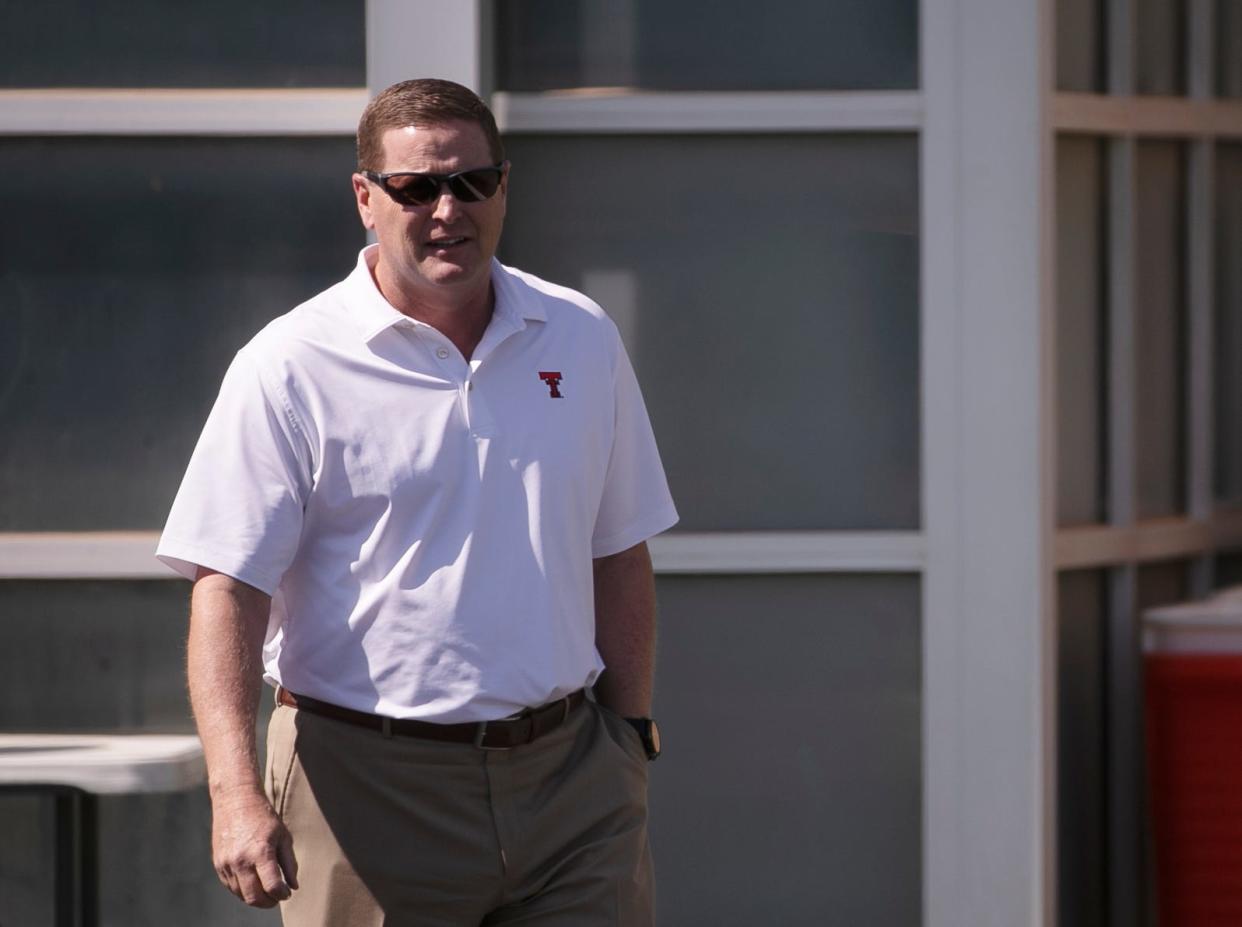How Texas Tech would handle the changes proposed by NCAA president Charlie Baker
Within the past week, workers began installing a new Double T scoreboard above the south end zone at Jones AT&T Stadium. Much anticipated, it's the latest visible component of the two-year Texas Tech football facilities project scheduled for completion in 2024.
Total cost for the project is projected at $242 million and, as of late January, Tech had $102 million in fundraising and pledges.
Simultaneously, Texas Tech athletics director Kirby Hocutt, like his colleagues all over the country, is thinking of ways to handle more financial obligations he believes are inevitable. The NCAA continues to face legal challenges that could force its members to share some of the revenue generated by major-college football and basketball along with giving athletes employment status.
"I think there's a new model that is coming forward that is going to lead to some type of revenue share with our student-athletes," Hocutt said recently, "which will obviously impact and alter all of the broad investments that we're making and others are making within their athletics program today.
"A new model's coming. Will student-athletes be employees or not? I don't know. But nonetheless, there's going to be changes coming."
Home game replacing road game: Texas Tech football adds opponent to 2025 schedule with pricey game guarantee
A level-by-level look: What's inside Texas Tech football's new end zone building at Jones AT&T Stadium
In December, new NCAA President Charlie Baker proposed some of the most drastic changes in the history of college sports' governing body. Among them: Forming a new tier in Division I sports in which higher-resourced schools opting in would invest into an educational trust fund at least $30,000 per year per athlete for at least half the athletes in their department.
Though Baker's proposal suggested half, Hocutt spoke in terms of making the investment for all eligible athletes in Tech's department. For about 400 athletes, that would be $12 million annually.
"I think about that all day and every day," Hocutt said. "Obviously, we're going to have to continue to grow revenue. We're going to have to be creative and find new revenue streams. We have been and are very fortunate that we continue to benefit from the generosity of so many donors and supporters and season-ticket holders.
"As we complete the south end zone and the Womble Football Center, I think you will start to see a new narrative and a redirection of our fundraising efforts that will move away from capital projects and move toward this new model and annual support in whatever direction this turns on us."
In its annual financial report to the NCAA, filed in January, Tech showed $146.8 million in operating revenue for fiscal year 2023 and an operating surplus of $10.4 million. Both figures, not adjusted for inflation, are all-time highs for the department, though deputy athletics director Jonathan Botros acknowledged the past fiscal year could be an outlier in that Tech put substantial gifts that had come in over previous years into the operating budget.

Texas Tech has a history of fully funding new initiatives
When power-five conference schools voted 79-1 in January 2015 to offer stipends making athletic scholarship values equal full cost of attendance, Tech was on board, adding more than $1 million to the athletics budget.
When the Supreme Court ruled in 2021 that the NCAA could not limit education-related benefits athletes can receive, Tech budgeted more than $1.8 million annually as a result. The department now pays qualifying athletes up to $5,980 a year in Alston academic awards, which are named for the former West Virginia running back who was plaintiff in the NCAA vs. Alston case.
Baker, a Republican governor of Massachusetts from January 2015 to January 2023, became NCAA president last March. In Baker's December letter to more than 350 NCAA Division I schools, he said the organization needs to "make several fundamental changes."
Among them: Possibly removing limits on roster sizes and the number of athletic scholarships a team can award. In other words, let the schools decide. Also, he suggested athletics departments do group licensing agreements with their players to bring name, image and likeness compensation in-house.
"First, we should make it possible for all Division I colleges and universities to offer student-athletes any level of enhanced educational benefits they deem appropriate," Baker wrote. "Second, rules should change for any Division I school, at their choice, to enter into name, image and likeness licensing opportunities with their student-athletes."
Hocutt didn't shy away from his ideas.
"We're going to continue to invest at the highest levels," Hocutt said, "and compete at the highest levels."
Not all members of a conference would have to be part of a new subdivision. Each school could make up its own mind. The shift would be for all sports, not just the major revenue generators, football and basketball.
"It would literally take the power-four (conference) schools and those that want to invest at the highest level," Hocutt said, "and really separate them from others (in Division I) in the investments that they're allowed to make, the rules that they want to make and how they operate.
"His proposal is doing that under the NCAA national governance umbrella. It does not touch on the separation of the sport of football. But I do think we're going to get to a point where there's further separation among the top conferences and everyone else."
Right now, the proposals are merely in the talking and feedback stages. There's no indication any or all components would ultimately pass legislation, but it's indicative of the direction college sports is heading.
"You've got this discussion and dialogue taking place through the NCAA governance model," Hocutt said. "Right now, that model is being vetted out by the Division I Council, and the Division I Council is made up of all Division I conferences. Well, if this is really going to be at the highest levels, that discussion group should be made up of four conferences, not 32 Division I conferences that make up the Division I Council."
Kirby Hocutt has had to cut sports before; would he do it again?
When the Texas Tech men's basketball team traveled to Waco last month to play Baylor, Hocutt went on to San Antonio to have lunch with Edward Whitacre Jr., the former Texas Tech regent who served stints as president and CEO of both AT&T and General Motors.
"When we sat down," Hocutt said, "the first thing he said was, I don't envy you. You've got a hard chair you're sitting in, from everything I read."
In addition to digesting Baker's plan for major-college athletics, schools could bear the fallout from lawsuits facing the NCAA and the power conferences.
"There continues to be conversation about how we're going to manage all of those lawsuits," Hocutt said. "Are we going to allow them to go to trial or is there a possible settlement? A couple of those lawsuits deal with pay-for-play, and there's discussions going on: Some of those lawsuits, do you mediate and settle those?
"Nonetheless, it's going to lead to some type of revenue share if there's mediation, and if that's the case, I would anticipate it being, based on what I know today ... somewhere in a $15 million to $20 million investment into your student-athletes."
Less than two years after Ohio University hired him as athletics director, Hocutt found himself in the awkward position of eliminating four of the school's sports teams. To address a $4 million budget deficit and meet Title IX requirements, Ohio U cut men's indoor and outdoor track and field, women's lacrosse and men's swimming and diving in early 2007.
"If memory serves me correctly," Hocutt said, "we were feeding our kids McDonald's on road trips. We were sleeping three or four student-athletes to a room. We just didn't have enough dollars to invest and be competitive in everything that we were trying to do."
Backlash from the athletes, their families and the alumni of those sports, he said, was "severe."
Texas Tech hasn't eliminated a sports program since the mid-1980s when it cut swimming and diving, and Hocutt doesn't plan for that to happen again. Texas Tech sponsors 17 sports teams, one more than the requirement for NCAA Division I membership.
When athletics departments were cash-strapped during the Covid pandemic, the NCAA declined to relax that requirement. With the NCAA facing legal challenges and the possibility of courts making college athletes employees, Hocutt said he thinks the requirement will come up for debate again.
"Do I think the minimum-sport requirement will be put on the table for further discussion as this new model evolves? Yes, I do," Hocutt said. "Do I want to be in a position where we have to reduce sport sponsorships? No, I don't. I went through that earlier in my career at Ohio University, and it's not something you want to do.
"Will that be put on the table? I would anticipate it will. Would we have to consider a reduction of sports? I hope not. At the same time, we're just speculating and trying to envision what it's going to look like in three to five years, so we would purely be guessing on what the decisions that are going to be in front of us are going to be."

This article originally appeared on Lubbock Avalanche-Journal: How Texas Tech would handle changes proposed by new NCAA president
